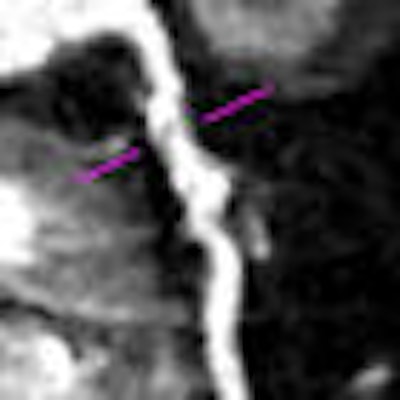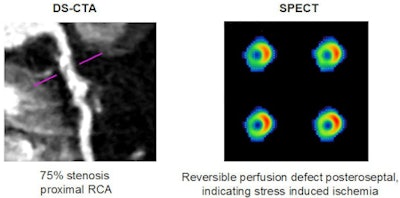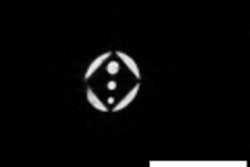
Dual-source CT angiography (CTA) achieves a high negative predictive value (NPV) in excluding coronary artery stenoses in patients with stable coronary artery disease, but the modality is "very limited" in its ability to predict the presence of ischemia, according to a study by German researchers.
The study, by a team based at the University of Munich's Department of Nuclear Medicine and Institute of Clinical Radiology, found that dual-source CT angiography's high negative predictive value was 89% with hemodynamically relevant coronary artery stenoses, using the criteria of lumen narrowing of 75% or greater.
Led by co-author Dr. Marcus Hacker, the research was designed to compare dual-source CTA with SPECT myocardial perfusion imaging in detecting hemodynamically relevant coronary artery stenosis in patients with stable coronary artery disease. Hacker presented the study at the 2009 SNM annual meeting.
Imaging protocols
The researchers evaluated 38 patients (29 men and nine women; mean age, 65 years) with known coronary artery disease, specifically in the left anterior descending, left circumflex, and right coronary arteries.
Dual-source CT angiography (Somatom Definition, Siemens Healthcare, Erlangen, Germany) and myocardial perfusion SPECT were performed within 40 days, with no revascularization performed during that interval.
"We used no beta-blockers, resulting in the high heart frequency of 70 beats per minute as average," Hacker said. "We defined our threshold for hemodynamically relevant coronary stenosis as 75% lumen narrowing, as we tried to achieve the preferred high positive predictive value."
Myocardial perfusion SPECT was performed on a triple-head gamma camera (Picker XP 3000, Philips Healthcare, Andover, MA) with a technetium-99m sestamibi radiopharmaceutical. Gated SPECT images were evaluated visually and quantitatively (QPS, Cedars-Sinai Medical Center, Los Angeles).
Image comparisons
When the images were analyzed, dual-source CTA could not conclusively quantify the degree of stenosis in 93 of 570 coronary segments, "which is a quite high rate of 16%," Hacker said. Dual-source CTA did detect stenoses of 75% or greater lumen narrowing in 31 of 114 (27%) coronary arteries, while occlusions were found in eight of 114 (7%) coronary arteries.
Of the 31 stenoses of 75% or greater lumen narrowing, myocardial perfusion imaging detected 11 reversible perfusion defects.
"We saw that in patients with stenosis of more than 75%, [dual-source CTA] showed reversible perfusion defects in 16 patients, while 11 patients showed no reversible perfusion defects, leading to a high sensitivity of 89% and a high negative predictive value of 82%." At the other end of the scale, specificity was 45% and positive predictive value was 59%.
 |
| Images of a 68-year-old man with a true-positive finding in the right coronary artery (RCA) of a stenosis with 57% lumen narrowing (left) and a reversible perfusion defect indicating stress-induced ischemia via myocardial perfusion SPECT (right). Images courtesy of Dr. Markus Hacker and the University of Munich. |
The group also found that in cases of stenosis with 75% or greater lumen narrowing, 20 vessels showed no reversible perfusion defects through dual-source CT angiography. When there was no evidence of a stenosis of greater than 75%, the study discovered nine relevant perfusion defects, leading to a limited sensitivity of 55%, with a high negative predictive value of 89%.
From those results, the researchers concluded that dual-source CT angiography achieved a "high negative predictive value of 89% in the exclusion of hemodynamic relevant coronary artery stenosis in patients with coronary artery disease when a threshold of 75% was chosen," Hacker said. "Otherwise, in the case of present stenosis for prediction of ischemia, dual-source CT was limited."
Most importantly, he added, the study found a "very high rate of 16% of nonevaluable segments in the setting of patients with advanced coronary artery disease, preventing, in our opinion, the use of this method as a single method in the follow-up of patients with coronary artery disease."
By Wayne Forrest
AuntMinnie.com staff writer
July 30, 2009
Related Reading
Adding PET to 64-slice CT aids detection of heart disease, July 20, 2009
Prospectively gated coronary CTA nearly equals normal-dose scans, July 17, 2009
Triple-rule-out CT scans benefit from prospective gating, May 28, 2009
Study correlates CTA to angiography, myocardial perfusion SPECT, May 25, 2007
Stress MPI with Tc-99m SPECT identifies high-risk obese patients, September 1, 2006
Copyright © 2009 AuntMinnie.com




















